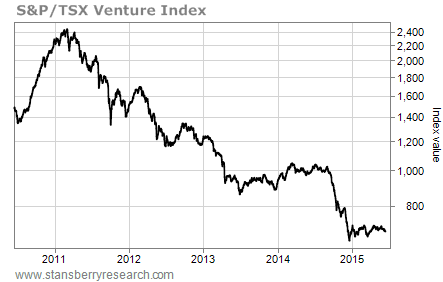Junior gold miners are banding together to survive…
And it’s a sign that we could soon see these stocks bottom.
Let me explain…
Regular Growth Stock Wire readers know junior mining stocks have been in “bust” mode over the past few years.
You can see this in the S&P/TSX Venture Index chart below. The Venture Index tracks the prices of hundreds of small energy and mining firms.
 As you can see, the Venture Index has lost more than 70% of its value since 2011.
As you can see, the Venture Index has lost more than 70% of its value since 2011.
[ad#Google Adsense 336×280-IA]Now, after many natural resources have fallen in price, these companies are struggling to stay in business.
For example, gold prices are down 38% since their August 2011 peak.
The low gold price has caused financing for junior gold miners to dry up.
A little more than 40% of the companies in the TSX Venture Exchange have less than $1 million in cash today, according to Bloomberg.
These companies are restricted without sufficient cash.
They’re explorers. They don’t sell anything. The cash in the bank is all they have to lease land, fund exploration costs, pay wages, and cover all other operating costs. And this is on top of the unpaid invoices (accounts payable) they already have.
In short, a small cash balance doesn’t go far. And it forces management to focus on raising money to pay its bills instead of exploring for gold to generate value for shareholders.
To survive, some of these companies are now consolidating.
On Tuesday, Oban Mining announced it will combine with Eagle Hill Exploration, Temex Resources, Ryan Gold, and Corona Gold. Oban will be the remaining company when the deal closes in August.
The deal came about when two mining gurus – Sean Roosen and Ned Goodman – decided to join forces.
Roosen is the CEO of gold-royalty firm Osisko Gold Royalties. He has worked in the precious-metals space for a long time, but his current company is relatively new. Roosen and his team formed it last year after selling their firm – Osisko Mining – to Yamana Gold and Agnico Eagle for almost $4 billion.
Since forming Osisko Gold, Roosen’s group has been one of the few that continue to provide capital to junior miners.
Goodman is the CEO of holding company Dundee Corporation. He has been working or financing deals in the resource industry since the 1950s. In 2012, he was inducted into the Canadian Mining Hall of Fame.
Osisko Gold and Dundee have some common investments in Canadian junior gold miners. And they wanted to combine a portion of their holdings.
Roosen told Canada’s Financial Post that a lot of “people have been talking about [consolidation]. We decided to do it.”
So Roosen and Goodman set out to merge Ryan Gold (which both of their companies are involved with), Oban (which Osisko is involved with), Corona (which Dundee is the largest shareholder of), and Eagle Hill (which Dundee is also the largest shareholder of), and Temex. Temex has assets in Northeastern Ontario, close to some of the former Osisko Mining’s projects.
Their goal was to “create an entity that’s sustainable and has the ability to hopefully re-rate in the marketplace and move these projects to where they have to go,” Roosen told the Financial Post.
The new company will control more than 280,000 acres of land… four projects… and more than 6 million ounces of gold resources. It expects to have a market cap of $122 million.
As part of the deal, Osisko will provide technical services, as well as legal and accounting support, to the new firm. And Osisko has said it will invest up to $20 million in the new company.
Assuming this, the new Oban will have $65 million in cash. It doesn’t currently produce gold… but this cash hoard will put it in a good place to achieve its goal of becoming an intermediate gold producer.
It’s not easy to bring five companies together, get them all to agree on terms, and close the deal. Since four companies cease to exist as part of this deal, a lot of people – many of them at the director and manager levels – will lose their jobs.
There’s also no guarantee the new Oban will be a success. But the new company has a much better chance than the old ones.
Other junior miners will be watching closely to see how this turns out… and the more proactive ones will copy it. I expect we’ll see more consolidations in the coming months.
And that’s good news for junior-gold-miner investors…
You see, deals like this have to happen for the sector to recover.
As I said, right now, too many junior miners are just trying to keep the lights on.
Once these companies either consolidate to become more productive or go bankrupt, the remaining firms will be more efficient… able to focus on exploring and developing mines and rewarding shareholders.
In short, as more junior gold miners consolidate or leave the sector, investors will have better options to choose from. And we could likely see a bottom in these stocks. Resource investors may want to start looking into the sector. Just remember – these stocks can be risky. So treat any investments in this sector as speculations.
Good investing,
Brian Weepie
Sponsored Link: If you’re looking to profit in the gold sector, my colleague Matt Badiali recommends gold-royalty companies. These companies mine no metals of their own… they’re shielded from swings in the price of gold… and they’ll be big beneficiaries of higher gold prices.
Matt has found the best-valued gold-royalty stocks on the market. And right now, several of them are in buy range. You can access all of Matt’s research on these companies with a risk-free trial subscription to the Stansberry Resource Report. Get all the details here.
Source: Growth Stock Wire
